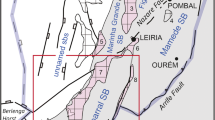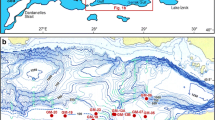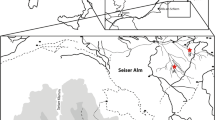Abstract
Early to late Pliocene sedimentary strata present across the northern Bass Strait hinterland, southeastern Australia yield extensive fossil proxy data relevant to the interpretation of high sea level coastal palaeomorphology. Within the Pliocene Whalers Bluff Formation exposed in coastal cliffs near the township of Portland, Victoria, marine microfossil faunas delineate two broad cycles of deposition. Both these sedimentary cycles are bound below by unconformity surfaces. Within the lower sedimentary cycle, a basal stress-tolerant (low diversity) marginal marine microfossil fauna devoid of ostracods and suggestive of bottom-water hypoxia, is succeeded by a diverse shallow marine ostracod fauna dominated by stenohaline species indicative of a sheltered (but open) oceanic embayment. This lower sedimentary cycle has an early Pliocene (Zanclean) age. Equivalent shallow marine (e.g. coastal embayment) deposits occur broadly across the coastal hinterland of southeastern Australia—reflecting the generally higher global sea levels of this time. The upper cycle in the cliff exposures at Portland is late Pliocene (Piacenzian) in age. Equivalent deposits across the Bass Strait hinterland are restricted to former incised river valley settings. Euryhaline estuarine/coastal lagoon Ostracoda are present throughout the upper cycle in the Portland cliffs. These are associated with a low diversity microfauna at the base of the upper cycle and a high diversity microfauna towards the top of the cycle. Early Pliocene coastal marine deposits can be distinguished from late Pliocene coastal marine deposits across the northern Bass Strait hinterland on the basis of the presence or absence of certain open marine (‘stenohaline’) ostracod species.






Similar content being viewed by others
References
Abele, C., P. R. Kenley, G. Holdgate & C. Ripper, 1976. Tertiary—Otway Basin. In Douglas, J. F. & J. A. Ferguson (eds), Geology of Victoria, 1st edn. Special Publication of the Geological Society of Australia No 5. Geological Society of Australia (Victorian Division), Melbourne: 198–229.
Andrews, E. C., 1910. Geographical unity of Eastern Australia in the late and post Tertiary time. Journal and Proceedings of the Royal Society of New South Wales 67: 251–350.
Beu, A. G. & T. A. Darragh, 2001. Revision of Southern Australian Cenozoic fossil Pectinidae (Mollusca: Bivalvia). Proceedings of the Royal Society of Victoria 113: 1–205.
Bolger, P. F., 1991. Lithofacies variations as a consequence of late Cainozoic tectonic and palaeoclimatic events in the onshore Gippsland Basin. In Williams, M. A. J., P. De Deckker & A. P. Kershaw (eds) The Cainozoic in Australia: A Re-appraisal of the Evidence. Special Publication of the Geological Society of Australia No 18: 158–180.
Boutakoff, N., 1963. The Geology and Geomorphology of the Portland Area: Geological Survey of Victoria. Memoir 22: 1–172.
Boutakoff, N. & R. C. Sprigg, 1953. Summary report on the Petroleum possibilities of the Mount Gambier Sunklands. Mining and Geology Journal of Victoria 5: 28–42.
Brady, G. S., 1880. Report on the Ostracoda dredged by HMS Challenger during the years 1873–1876. Report on the Scientific Results of the Voyage of HMS Challenger. Zoology 1(3): 1–184.
Brady, G. S., 1866. On new or imperfectly known species of marine Ostracoda. Transactions of the Zoological Society of London 5(5): 359–393.
Carter, A. N., 1964. Tertiary Foraminifera from Gippsland, Victoria and their stratigraphical significance. Geological Survey of Victoria Memoir 23: 1–154.
Carter, A. N., 1985. A model for depositional sequences in the Late Tertiary of south-eastern Australia. In Lindsay, J. M. (ed.), Stratigraphy, Palaeontology, Malacology. Papers in Honour of Dr Nell Ludbrook. Special Publication No 5. Department of Mines and Energy, South Australia: 13–27.
Chapman, F. & I. Crespin, 1928. III. Description of new and rare species. In Chapman, F., I. Crespin & A. Keble (eds), The Sorrento Bore, Mornington Peninsula, with a Description of New or Little-Known Fossils. Records of the Geological Survey of Victoria, 5(1), 1–195, pl. I–XII.
Crespin, I., 1950. Report on an examination of fossils from the Portland Area South-Western Victoria collected by Dr Boutakoff. Bureau of Mineral Resources, Geology and Geophysics, Records 1950/28.
Darragh, T. A., 1985. Molluscan biogeography and biostratigraphy of the Tertiary of southeastern Australia. Alcheringa 9: 83–116.
Dickinson, J. A., M. W. Wallace, G. R. Holdgate, S. J. Gallagher & L. Thomas, 2002. Origin and timing of the Miocene-Pliocene unconformity in southeast Australia. Journal of Sedimentary Research 72: 288–303.
Fitzgerald, E. M. G., 2005. Pliocene marine mammals from the Whalers Bluff Formation of Portland, Victoria, Australia. Memoirs of Museum Victoria 62: 67–89.
Gallagher, S. J., D. R. Greenwood, D. Taylor, A. J. Smith, M. W. Wallace & G. R. Holdgate, 2003. The Pliocene climatic and environmental evolution of southeast Australia: evidence from marine and terrestrial realm. Palaeogeography, Palaeoclimatology, Palaeoecology 193: 349–382.
Haq, B. U., J. Hardenbol & P. R. Vail, 1987. Chronology of fluctuating sea levels since the Triassic. Science 235: 1156–1167.
Hartmann, G., 1978. Die Ostracoden der Ordnung Podocopida der tropischen-subtropischen Westküste Australiens (Zwischen Derby im Norden und Perth im Süden). In: Hartmann, G. & G. Hartmann-Schröder. Zur Kenntnis des Eulittorals der australischen Küsten unter besonderer Berücksichtigung der Polychaeten und Ostracoden. Tl. 2, Mitteilungen aus dem Hamburgischen Zoologischen Museum und Institut 75: 64–219.
Hartmann, G. 1980. Die Ostracoden der Ordnung Podocopida G.W. Müller, 1894 der warm-temperierten und subtropisch-tropischen Küstenabschnitte der Süd-und Südostküste Australiens (zwischen Ceduna im Westen und Lakes Entrance im Osten). Mitteilungen aus dem Hamburgischen zoologischen. Museum und Institut 77: 111–204.
Hartmann, G., 1982. Beitrag zur Ostracodenfauna Neuseelands (mit einem Nachtrag zur Ostracodenfauna der Westküste Australiens). Mitteilungen aus dem Hamburgischen Zoologischen Museum und Institut 79: 119–150.
Hendy, A. J. W. & P. J. J. Kamp, 2007. Paleoecology of Late Miocene-Early Pliocene sixth-order glacioeustatic sequences in the Manutahi-1 core, Wanganui-Taranaki Basin, New Zealand. Palaíos 22: 325–337.
Hill, K. C., K. A. Hill, G. A. Cooper, A. J. O’Sullivan, P. B. O’Sullivan & M. J. Richardson, 1995. Inversion around the Bass Basin, SE Australia. In Buchanan, J. G. & P. G. Buchanan (eds), Basin Inversion. Geological Society Special Publication No 88: 525–547.
Hill, P. J., P. De Deckker, C. von der Borch & C. V. Murray-Wallace, 2009. Ancestral Murray River on the Lacepede Shelf, southern Australia: Late Quaternary migrations of a major river outlet and strandline development. Australian Journal of Earth Sciences 56: 135–157.
Hocking, J. B., 1976a. Definition and revision of Tertiary stratigraphic units, onshore Gippsland Basin. Report of the Geological Survey of Victoria 1976(1): 1–40.
Hocking, J. B., 1976b. Tertiary—Gippsland Basin. In Douglas, J. G. & J. A. Ferguson (eds), Geology of Victoria. Special Publication of the Geological Society of Australia No 5, 1st ed. Geological Society of Australia (Victorian Division), Melbourne: 248–273.
Holdgate, G. R. & S. J. Gallagher, 2003. Chapter 10. Tertiary. In Birch, W. D. (ed.), Geology of Victoria, 3 edn. Special Publication No 23. Geological Society of Australia (Victorian Division), Melbourne: 377–433.
Holdgate, G. R., M. W. Wallace, S. J. Gallagher, A. J. Smith, J. B. Keene, D. Moore & S. Shafik, 2003. Plio-Pleistocene tectonics and eustasy in the Gippsland Basin, southeast Australia: evidence from magnetic imagery and marine geological data. Australian Journal of Earth Sciences 50: 403–426.
Ikeya, N., T. Jellineck & A. Tsukagoshi, 1998. Cythere pumila Brady 1866 (Crust., Ostracoda): variation or speciation? An example from Recent south Australia shores. Paläontologische Zeitschrift 72(3/4): 311–324.
International Commission on Stratigraphy (International Union of Geological Sciences), 2009. International Stratigraphic Chart [available on internet at http://www.stratigraphy-org/upload/ischart2009.pdf]. Accessed 2009, November 19.
Leach, A. S. & M. W. Wallace, 2001. Cenozoic Submarine Canyon Systems in Cool Water Carbonates from the Otway Basin, Victoria, Australia. In Hill, K. C. & T. Bernecker (eds), PESA Eastern Australian Basins Symposium. Petroleum Exploration Society of Australia, Melbourne: 465–473.
Lisiecki, L. E. & M. E. Raymo, 2005. A Pliocene-Pleistocene stack of 57 globally distributed benthic δ18O records. Paleoceanography 20: PA1003. doi:10.1029/2004PA001071.
Ludbrook, N. H., 1973. Distribution and Stratigraphic Utility of Cenozoic Molluscan Faunas in Southern Australia. Tohoku University Science Reports, 2nd series, Special Volume 6: 241–261.
Mallett, C. W., 1977. Studies in Victorian Tertiary Foraminifera; Neogene Planktic Faunas. PhD Thesis, University of Melbourne: 79–83.
Mallett, C. W., 1978. Sea level changes in the Neogene of Southern Victoria. APEA Journal 1978: 64–68.
Mallett, C. W. & G. R. Holdgate, 1985. Subsurface Neogene stratigraphy of Nepean Peninsula, Victoria. In Lindsay, J. M. (ed.), Stratigraphy, Palaeontology, Malacology: Papers in Honour of Dr Nell Ludbrook. Special Publication No 5. Department of Mines and Energy, South Australia: 233–245.
McKenzie, K. G., 1967. Recent Ostracoda of Port Phillip Bay, Victoria. Proceedings of the Royal Society of Victoria 80: 61–106.
McKenzie, K. G., 1978. Ostracoda (Crustacea: Podocopida) from southern Australian salt lakes, with the description of Reticypris new genus. Transactions of the Royal Society of South Australia 102: 175–190.
McKenzie, K. G., R. A. Reyment & E. R. Reyment, 1990. Pleistocene and Recent Ostracoda from Goose Lagoon Drain, Victoria and Kingston, South Australia. Bulletin of the Geological Institutions of the University of Uppsala N.S. 16: 1–46.
Miller, K. G., M. A. Koiminz, J. V. Browning, J. D. Wright, G. S. Mountain, M. E. Katz, P. J. Sugarman, B. S. Cramer, N. Christie-Blick & S. F. Pekar, 2005. The Phanerozoic Record of Global Sea-Level Change. Science 310: 1293–1298.
Miranda, J. A., M. W. Wallace & S. McLaren, 2008. The Norwest Bend Formation: implications for the evolution of Neogene drainage in southeastern Australia. Sedimentary Geology 205: 53–66.
Miranda, J. A., M. W. Wallace & S. McLaren, 2009. Tectonism and eustasy across a Late Miocene strandplain: The Loxton-Parilla Sands, Murray Basin, southeastern Australia. Sedimentary Geology 219: 24–43.
Mitchell, J. K., G. R. Holdgate & M. W. Wallace, 2007. Pliocene-Pleistocene history of the Gippsland Basin outer shelf and canyon heads, southeast Australia. Australian Journal of Earth Sciences 54(1): 49–64.
Neil, J. V., 2000. A recent ostracode assemblage from Erith Island, Bass Strait, southern Australia—geographical and ecological comparisons with a description of a new species of Rotundracythere (Ostracoda: Crustacea). Proceedings for the Royal Society of Victoria 112: 119–132.
Pufahl, P. K., N. P. James, Y. Bone & J. J. Lukasik, 2004. Pliocene sedimentation in a shallow, cool-water, estuarine gulf, Murray Basin, South Australia. Sedimentology 51: 997–1027.
Schultz, M. B., D. A. Ierodiaconou, S. A. Smith, P. Horwitz, A. M. M. Richardson, K. A. Crandall & C. M. Austin, 2008. Sea-level changes and palaeo-ranges: reconstruction of ancient shorelines and river drainages and the phylogeography of the Australian land crayfish Engaeus sericatus Clark (Decapoda: Parastacidae). Molecular Ecology 17: 5291–5314.
Scott, D. B., F. S. Medioli & C. T. Schafer, 2001. Monitoring in coastal environments using Foraminifera and Thecamoebian indicators. Cambridge University Press, Cambridge: 1–177.
Singleton, F. A., 1941. The Tertiary geology of Australia. Proceedings of the Royal Society of Victoria 53: 1–118.
Singleton, O. P., I. McDougall & C. W. Mallett, 1976. The Pliocene-Pleistocene boundary in southeastern Australian. Journal of Geological Society of Australia 33: 299–311.
Vandenberghe, N. & J. Hardenbol, 1998. Introduction to the Neogene. In de Graciansky, P., J. Hardenbol, T. Jacquin & P. R. Vail (eds), Mesozoic and Cenozoic Sequence Stratigraphy of European Basins: SEPM Special Publication 60: 83.
Wallace, M. W., J. A. Dickinson, D. H. Moore & M. Sandiford, 2005. Late Neogene strandlines of southern Victoria: a unique record of eustasy and tectonics in southeast Australia. Australian Journal of Earth Sciences 52: 277–295.
Warne, M. T., 1986. Paranesidea and Papillatabairdia (Ostracoda) from the Miocene of the Port Phillip and Western Port Basins. Proceedings of the Royal Society of Victoria 98(1): 41–48.
Warne, M. T., 1987. Lithostratigraphical associations of the ostracod fauna in the marine Neogene of the Port Phillip and Western Port Basins, Victoria, south-eastern Australia. In McKenzie, K. G. (ed.), Proceedings of the International Symposium on Shallow Tethys 2, Wagga Wagga, 15–17th September, 1986. A. A. Balkema, Rotterdam: 435–445.
Warne, M. T., 1988. Micropalaeontological evaluation of eustatic and tectonic influences on late Tertiary sedimentation; south-central Victorian coast. Abstracts from the Victorian Universities Geology Conference 1988, Earth Science Department, Monash University. Geological Society of Australia (Victorian Division), Melbourne, Australia.
Warne, M. T., 1993. Micropalaeontological evaluation of eustatic and tectonic influences on late Tertiary marine sedimentation within the Port Phillip and Western Port Basins, Victoria, Australia. In: McKenzie, K. G. & P. J. Jones (eds), Ostracoda in the Earth and Life Sciences. Proceedings of the Eleventh International Symposium on Ostracoda, Warrnambool, Victoria, Australia, 8–12 July, 1991. A.A. Balkema, Rotterdam, Netherlands: 259–275.
Warne, M. T., 2002a. Palaeo-geomorphological significance of Miocene and Pliocene euryhaline Ostracoda in the Nepean 1 borehole, Port Phillip Basin, SE Australia. Memoirs of the Association of Australasian Palaeontologists 27: 139–148.
Warne, M. T., 2002b. Palaeosalinity transformations of the Miocene-Pliocene boundary in south-eastern Australia: evidence from fossil Ostracoda. Geological Society of Australia Abstracts 67: 399.
Warne, M. T., 2004. Description of Loxocythere (Novoloxocythere) pelius subgen et sp.nov. (Ostracoda) from the Cenozoic of S.E. Australia with comments on species of Antarctiloxoconcha Hartmann, 1986 and Loxoreticulatum Benson, 1964 from Australian and Antarctic marine waters. Proceedings of the Royal Society of Victoria 116(2): 247–255.
Warne, M. T., 2005. The global Mio-Pliocene climatic equability and coastal ostracod faunas of southeast Australia: Palaeogeography, Palaeoclimatology. Palaeoecology 225: 248–265.
Warne, M. T. & B. Soutar, 2006. Pliocene marine microfossils, sequence stratigraphy and palaeoenvironments of the Whalers Bluff Formation, Otway Basin, S.E. Australia. In Conference Abstracts, Revised Version (ISBN 0-646-46366-7), CD-ROM, Australian Earth Science Conference, (AESC 2006). Geological Society of Australia, Melbourne.
Warne, M. T., N. Archbold, P. Bock, T. Darragh, M. Dettmann, J. Douglas, R. Gratsianova, M. Grover, D. Holloway, F. Holmes, R. Irwin, P. Jell, J. Long, R. Mawson, A. Partridge, J. Pickett, T. Rich, J. Richardson, A. Simpson, J. Talent & A. Vandenberg, 2003. Chapter 24: Palaeontology: the biogeohistory of Victoria. In Birch, B. W. (ed.), The Geology of Victoria, 3 edn. Geological Society of Australia Special Publication 23. Geological Society of Australia (Victorian Division), Melbourne: 605–652.
Whatley, R. C. & S. E. Downing, 1983. Middle Miocene Ostracoda from Victoria, Australia. Revista Española de Micropaleontología 15(3): 347–407.
Wornardt, W. W. Jr., 1999. Revision of Sequence Boundaries and Maximum Flooding Surfaces: Jurassic to Recent. In Offshore Technology Conference, OTC14072, 6th May, 1999, Houston, Texas: 1–18.
Yassini, I. & B. G. Jones, 1987. Ostracoda in Lake Illawarra: environmental factors, assemblages and systematic. Australian Journal of Marine and Freshwater Research 38: 793–843.
Yassini, I. & B. G. Jones, 1995. Foraminiferida and Ostracoda from estuarine and shelf environments of southeastern coast of Australia. University of Wollongong Press, Wollongong: 1–484.
Yassini, I., B. G. Jones, R. J. King, M. Ayress & K. T. Dewi, 1995. Ostracod fauna associated with sublittoral Kelp Forrest vegetation of Windang Island, New South Wales, Australia. Marine and Freshwater Research 46: 1181–1194.
Acknowledgements
Dr Thomas Darragh is thanked for assistance with fossil molluscan identification and for providing information on molluscan ecology. Dr Gary Poore is thanked for access to Museum Victoria ostracod collections. Mark Warne thanks Deakin University for funding to attend the 16th International Symposium of Ostracoda, Brazil, where this article was initially presented. Deakin University is also thanked for access to laboratory facilities for the conduct of this research and for support via the “Environmental Sustainability” Faculty of Science and Technology Research Cluster. Three reviewers are thanked for their useful criticisms of the initial draft of this article.
Author information
Authors and Affiliations
Corresponding author
Additional information
Guest editors: D. A. Dermeval, R. L. Pinto & K. Martens / Ostracoda – Biostratigraphy and Applied Ecology
Rights and permissions
About this article
Cite this article
Warne, M.T., Soutar, B. Pliocene coastal palaeomorphology and ostracod faunas of the Bass Strait hinterland, southeast Australia. Hydrobiologia 688, 93–112 (2012). https://doi.org/10.1007/s10750-011-0777-2
Published:
Issue Date:
DOI: https://doi.org/10.1007/s10750-011-0777-2




